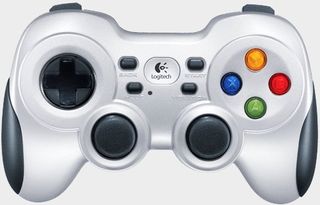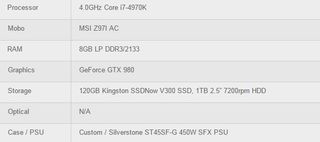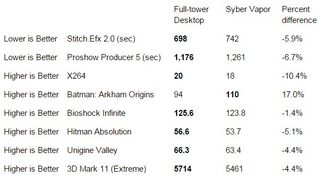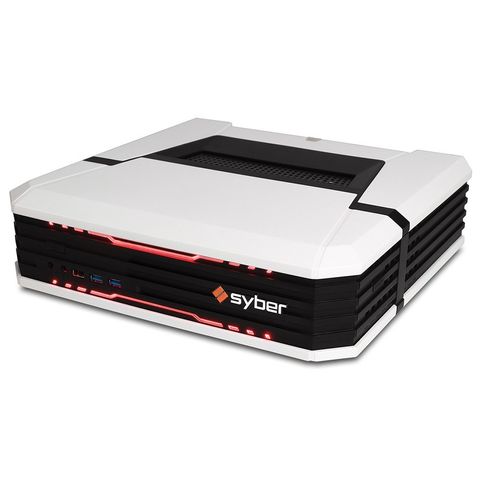PC Gamer's got your back
Vapor
Powerful; great value; runs quiet; includes K400 keyboard; plenty of ports.
Vaporware
Not portable; no keyboard/mouse emulation for controller; Big Picture Mode isnt perfect.
A Steam box for the enthusiast
Much like what Alienware did with its Alpha console, CyberPower PC is transforming its Steam Machine into a Windows box (you can thank Valve’s delay of its hardware initiative for that). CyberPower PC is branding its new line of PCs under its Syber Vapor line, which is an obvious nod to Valve’s “Steam” nomenclature. Unlike the Alienware Alpha, however, there is no proprietary 10-foot UI here. Rather, the Vapor boots directly into Steam’s Big Picture Mode . CyberPower PC is billing the Vapor as “the ultimate PC gaming console,” and with some minor quibbles aside, we think the company makes a pretty compelling argument.
Arguably, our biggest issue with the Vapor is that it’s... well, pretty big. Don’t get us wrong, at 13.8x13.5x3.8 inches it’s certainly a lot smaller than most gaming desktop PCs, but unlike Alienware’s much smaller Alpha, the Vapor is much too big for backpacks. It wouldn’t even fit in our Everki Beacon backpack, to which, as you might remember, we awarded a 9 Kick Ass and praised for being able to carry large 17-inch gaming notebooks. The portability problem is also exacerbated by the Vapor’s weight—it’s heavy. Whereas the Alpha was a tiny bundle of joy to lug around at 4.5 pounds, the Vapor is likely to strain backs, weighing in at 15 pounds.
There are seven LED color schemes to choose from.
While it is a bit larger than Microsoft’s Xbox One, it looks more like a console than a PC. The version that we got is white with black trim, but it also comes in an all-black chassis. Even though we like the look of both, we prefer the black and white version a bit more for its contrasting hues. Both color variants offer LED lights on the front, with six colors schemes to choose from via a physical button on top of the case. The colors include red, blue, green, light-green, light-blue, and purple. There’s also an option to have the case cycle through all the colors automatically. There’s something of a Tron vibe to the chassis, but we kind of like it in this case (no pun intended). You can also turn off the LEDs if they don’t appeal to you.
Even though Alienware’s Alpha was somewhat modular and allowed you to swap out the storage, RAM, and CPU, that’s about all you could change. With the Syber Vapor, it’s much less proprietary and just about as modular as any Mini-ITX system. It can take a single full-length graphics card, handle up to 16GB of RAM, and can house a standard SFX PSU up to 800 watts.
The Syber Vapor boots directly into Steam Big Picture Mode
While CyberPower PC comes with a wireless controller, instead of going with the wireless Xbox 360 controller (like the Alienware Alpha), the Vapor includes a Logitech F710 gamepad. The button layout is similar to Microsoft’s equivalent, but the shape of the controller feels similar to Sony’s Dual Shock offering, in that there are dual sticks toward the bottom-middle of the controller. The F710 works OK, but we prefer the Xbox 360 controller, as it contours better to our hands. The F710 isn’t the only peripheral that CyberPower PC included with our unit, however. While some of the more affordable models in the Vapor line include a wireless mini QWERTY keyboard, our system came with Logitech’s K400 wireless keyboard. The K400 has a little touchpad to the right of the keys, so you can mouse around. CyberPower PC opted to include this because, unlike Alienware, it didn’t program its controller to emulate a mouse-and-keyboard setup. While we would have really appreciated this feature, and feel it’s sort of a cheap shortcut on CyberPower PC’s part, the inclusion of the K400 keyboard does open up the system as both a Steam box and a full-fledged Windows PC (You can get to the Windows desktop by exiting Steam). Whereas it was a bit of a chore having to rely solely on a wireless Xbox 360 gamepad to control the Alpha, the Vapor’s included K400 does go a long way to mitigate annoying installation pop-ups in Steam Big Picture Mode. On a related note, as hard as Valve has worked on BPM, it still has some issues to iron out.

The case also comes in black.
When it came to our Vapor’s specs, we had little to complain about. While there are a couple of different configurations to choose from, CyberPower PC sent us its super-decked-out SKU, which includes components such as Intel’s 4GHz quad-core i7-4790K CPU coupled with Zalman’s CNPS8900 Quiet CPU cooler, Nvidia’s GeForce GTX 980, and 8GB of Corsair Vengeance lower-power DDR3 RAM clocked at 2,133MHz. All of this is sitting on top of an MSI Z97I AC Mini-ITX mobo and has a 450-watt Silverstone ST45SF-G SFX PSU. And for storage, our Vapor has a 120GB Kingston SSD and a 1TB 2.5-inch 7,200rpm HDD. All in all, this is nearly as much computer power as CyberPower PC can cram into this box. The cost of our unit? At the time of print, our particular SKU retails for $1,638 and while that certainly prices it well beyond the consoles, it’s actually quite a bargain. As a matter of fact, when we searched for all the individual components on Newegg to try and replicate the build ourselves, the total tab came out to be $1,807. So, you’re easily saving over $150 here, and you’re getting CyberPower PC’s one-year warranty on top of that. That’s some OEM voodoo right there.
To see how it compares to a full-tower DIY system with the same components, we look at the desktop featured in the cover story of our February 2015 issue, which conveniently has the same CPU and GPU. As would be expected, the bigger chassis allowed our desktop to perform slightly better overall, with the Vapor trailing behind one to five percent in our graphics tests. The only graphics benchmark where the Vapor was actually able to outperform our desktop equivalent was in Batman: Arkham Origins, but we suspect it’s because of the newer GeForce drivers we’ve got running compared to the build we originally set up for the February issue. As a gaming machine, our Vapor is a beast and should be able to max out any game you throw at it with smooth framerates. If anything, our unit is overkill for 1080P, with the upside being that it’s a bit more “future proof.” One of our complaints about Alienware’s Alpha is that it didn’t support GeForce Optimal Playable Settings, which is great for console noobs who don’t want to finagle with adjusting graphics settings. With our Vapor, users can simply set everything to max. It’s a brute-force way of tackling a complex problem, but hey, in this case, it works.

Our Syber Vapor came with Logitech's K400 wireless keyboard
When it came to the CPU benchmarks, the Vapor trailed the desktop by 5 to 10 percent, but we suspect that mostly has to do with our desktop’s Kraken X61, which is a great CPU liquid cooler. The Vapor is definitely running high-end desktop parts, but its form factor tames its components ever so slightly. But let’s be honest here, a 4790K is overkill for gaming today.
Considering the Vapor is meant to connect to your HDTV, all of the power in this box is moot if the user experience isn’t good. Because the Vapor runs Windows 8.1, users will have to go through the annoying Windows 8.1 setup process. Once we got that out of the way, we noticed that the Vapor scaled perfectly to our 1080p Samsung HDTV over HDMI. We couldn’t say the same about the Alienware Alpha, which required us to rejigger our display to fit the confines of the screen. Unfortunately, some games like SpeedRunners boot up in windowed mode, which takes you out of the illusion that you’re playing on a console. And speaking of booting, the startup process took 16 seconds to get to Windows, but then the Vapor automatically boots into Steam Big Picture Mode after that and kicks up the timer to 30 seconds overall. That’s not super-fast, but it’s much faster than the Alienware Alpha, which takes more than three times as long to boot. We have to say that we really missed being able to use the gamepad to emulate the mouse and keyboard, however, as that did work for Alienware’s box in a pinch. Really, who wants to go looking for their wireless keyboard whenever you’re playing a Steam game with only partial controller support? One thing that we really liked about the experience, however, is that our Vapor ran very quietly under load.

CyberPower includes Logitech's F710 wireless controller
We had some relatively small minor issues with the build quality. The unit we tested was actually our second unit; the first unit we received was dead on arrival. But hey, that stuff happens every now and then. The replacement unit reviewed here had its top lid pretty much fall off out of the box; its single screw wasn’t secured all the way. We tightened it easily enough, but then when we placed the Vapor flat on its side (which is one of the ways you can orient the box), one of the rubber feet came off (there was enough adhesive on it to stick it back in place). Little issues like these make us question CyberPower PC’s assembly line.
The Syber Vapor certainly isn’t perfect, and neither is Steam’s Big Picture Mode, but as a Mini-ITX gaming PC, it rocks, especially for the price. At this point, you literally cannot beat its price if you tried to DIY. In addition, it’s got enough horsepower to eat any 1080p game you throw at it. Yes, it’s relatively big and heavy, and a part of us would have preferred a smaller, cheaper, and more portable unit with a short GTX 970, but as it stands, this is still one pretty kick ass gaming PC.
Syber Vapor Specs

Syber Vapor Benchmarks

Our full-tower desktop PC uses an Nvidia GeForce GTX 980 and an Intel Core i7-4970K CPU.


